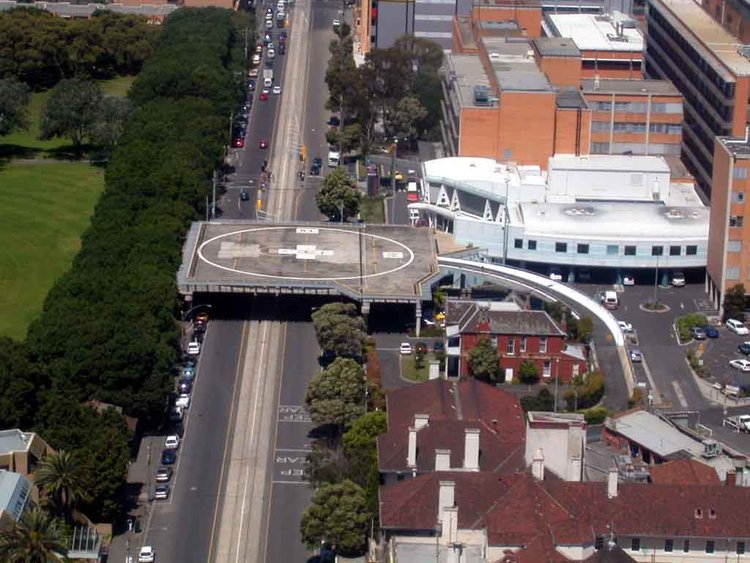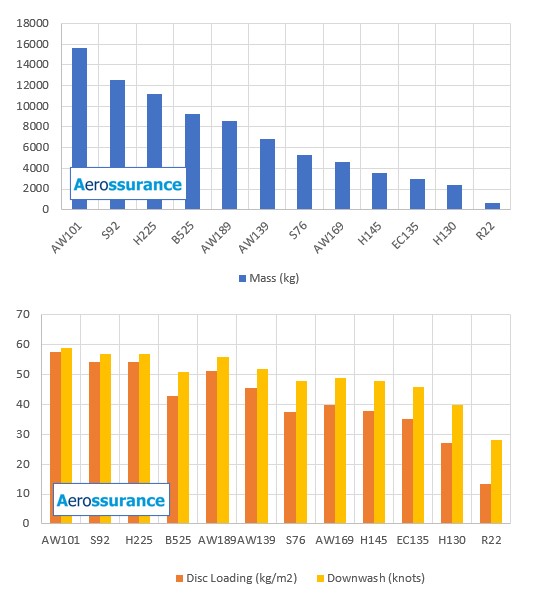Pedestrian Seriously Injured by Air Ambulance Landing at Melbourne Hospital (AW139 at The Alfred Trauma Centre HLS)
The Australian Transport Safety Bureau (ATSB) report that on 28 October 2021, while a Leonardo AW139 air ambulance helicopter was landing at The Alfred Hospital Helicopter Landing Site (HLS) in Melbourne, Victoria a passer-by walking along Commercial Road, under the approach path, was blown over and seriously injured. ATSB identify neither the helicopter registration nor the operator. Ambulance Victoria contract five AW139s.
The 39 by 42 m elevated Alfred’s HLS opened in 1988 as part of the development of Australia’s first dedicated trauma centre, instituted as part of a programme to tackle major road injuries in particular. It has been claimed that the availability of this centre, one of only two adult trauma centres in the state, has reduced the road traffic death rate by 50% in the state (VIDEO 1). The ATSB explain that:
The crew approached the helipad from the west [at about 15:50 Local Time], using a steep approach profile aligned with Commercial Road.
There does not appear to have been any subsequent assessment of FDR data to verify the approach. The pedestrian was “about 50 m” to the west of the HLS when they were blown over.
The Alfred HLS is located on an elevated platform approximately 8 m above Commercial Road, a publicly accessible thoroughfare with both vehicular [road and tram] and foot traffic. This design is unique in Australia, exposing public vehicles and pedestrians to the possibility of helicopter downwash on landing.
VIDEO 2: B412 approach and landing at The Alfred Hospital HLS from the west  Previously helicopters had landed in Fawkner Park on the opposite side of Commercial Road. The elevated site was given a A$250,000 lighting upgrade in 2021. The ATSB also comment that they have…
Previously helicopters had landed in Fawkner Park on the opposite side of Commercial Road. The elevated site was given a A$250,000 lighting upgrade in 2021. The ATSB also comment that they have…
…received reports of 5 rotor wash events at various hospital HLSs since 2016. Of these, 3 occurred at The Alfred hospital HLS and all involved AW139 helicopters.
After the incident the helicopter operator temporarily ceased operations from the site. They only recommenced operations after they had:
- Reduced the maximum number of helicopters on the helipad from two to one, removing the requirement to hover taxi away from the centre of the helipad
- Implemented pedestrian marshalling procedures for all helicopter movements, so that operations will only occur when no pedestrians are within 30 m of the helipad.
The hospital has also commissioned a study of the site.
Local HLS Regulations and Standards
In Australia, CASA CAAP 92-2(2) provides ‘Guidelines for the establishment and operation of onshore Helicopter Landing Sites'(last updated in 2014). The Victorian Health Building Authority (VHBA) also publish Guidelines for helicopter medical transport landing sites Issued June 2020 and rebranded in June 2021). VIDEO 3: AW139 take off from The Alfred Hospital HLS to the west:  VIDEO 4: AW139 take off from The Alfred Hospital HLS to the west VIDEO 5: B412 take off from The Alfred Hospital HLS to the north
VIDEO 4: AW139 take off from The Alfred Hospital HLS to the west VIDEO 5: B412 take off from The Alfred Hospital HLS to the north
ATSB Safety Message
Helicopters produce significant main rotor downwash, especially during hover taxi, take-off and while approaching to land. It is important that the risk of downwash related injuries, either by direct exposure or by being struck by loose items, be assessed prior to using a helicopter landing site (HLS). As pilots have limited ability to reduce rotor downwash during these phases of flight, securing loose items in the vicinity of the HLS and keeping people a safe distance away are the most effective ways of preventing injury.
UPDATE 3 March 2022: A fatality occurred at the Derriford Hospital in Plymouth, UK during the landing of a SAR helicopter at the hospital helipad (which is built on sloping ground surrounded by roads and car parks within the hospital site, which opened in 2015). Two people on the ground were injured. One, an 87 year old woman, later died of her injuries.
Our Observations
Not infrequently we find that non-aviation stakeholders misunderstand the physics of downwash, erroneously believing that smaller helicopters have significantly less downwash than larger types. An AW139 has a maximum take off mass of c62% of an S-92A and an EC135 is at c24% of the S-92A mass. However, the downwash velocity of the AW139 is c91% of the S-92A and the EC135 is at 80% of the S-92A, less, but still substantial.
Other Downwash Challenges
UPDATE 12 January 2023: Brighton’s Royal Sussex hospital helipad delayed again over cladding: External cladding on the top ten metres of the Thomas Kemp Tower building at the Royal Sussex County Hospital in Brighton will need to be reattached “after fears that landing helicopters could blow cladding off the building”. The helideck has a D-value of 28 m and a structural t-value of 15.6t.
UPDATE 5 March 2023: Final helideck works underway at the Royal Sussex County Hospital in Brighton
Cladding around the top section of the Thomas Kemp Tower at the hospital is being removed, checked and reattached as a precaution to ensure the helideck can be used safely.
The work started in February and is scheduled to last 30 weeks, although the exact completion date is partially dependent on weather conditions.
UPDATE 27 September 2023: ATSB issues safety advisory after series of rotor wash injuries at hospital helicopter landing sites
“Of the 18 helicopter rotor wash incidents reported to the ATSB in the last five years, nine occurred at hospital landing sites,” ATSB Director Transport Safety Dr Stuart Godley said. “Six of those nine occurrences resulted in injuries to pedestrians who were within approximately 30 m of the landing site, and flight crew were not aware of the presence of pedestrians in all cases. “In fact, in most instances, flight crew were not aware any incident had occurred at the time.”
Significantly, there were no reported occurrences of rotor wash related injuries at hospital HLS prior to the notable increase in the utilisation of AW139 for medical transport operations from 2017.
To enable the continued safe use of these facilities, hospital HLS owners and helicopter operators should ensure pedestrians are not affected by rotor wash by implementing appropriate risk controls for their HLS in addition to the helicopter operating procedures. Controls may include physical barriers, warning devices such as sirens, lights, high visibility warning signs, painted lines on nearby public thoroughfare to alert pedestrians to the rotor wash danger area, an inspection schedule for the HLS facility and surrounding area, and establishing a closed-loop reporting system.
Read the ATSB Safety Advisory Notice here: Safety at hospital helicopter landing sites
Read the ATSB Aviation Data and Analysis Report here: Downwash incidents at helicopter landing sites
Safety Resources
BP has shared a useful video on the threat of downwash (albeit with focused on closer proximity to HLS / offshore helidecks): 
The European Safety Promotion Network Rotorcraft (ESPN-R) has a helicopter safety discussion group on LinkedIn. You may also find these Aerossurance articles of interest:
- FOD and an AS350B3 Accident Landing on a Yacht in Bergen
- Air Methods AS350B3 Air Ambulance Tucson Tail Strike
- Air Ambulance B407 Hospital Helipad Deck Edge Tail Strike During Shallow Approach
- South Korean Fire-Fighting Helicopter Tail Rotor Strike on Fuel Bowser
- NTSB on LA A109S Rooftop Hospital Helipad Landing Accident
- Air Ambulance Helicopter Fell From Kathmandu Hospital Helipad (Video)
- US Air Ambulance Near Miss with Zip Wire and High ROD Impact at High Density Altitude
- Grand Canyon Air Tour Tragic Tailwind Landing Accident
- Air Ambulance Helicopter Downed by Fencing FOD
- Hanging on the Telephone… HEMS Wirestrike
- Helideck Safety Alerts: Refuelling Hoses and Obstructions
- NTSB Recommendations on Offshore Gas Venting
- Mind the Handrail! – Walk-to-Work Helideck Hazard
- TCM’s Fall from SAR AW139 Doorway While Commencing Night Hoist Training
- RLC B407 Reverses into Sister Ship at GOM Heliport
- UPDATE 5 March 2022: Taxiing AW139 Blade Strike on Maintenance Stand
- UPDATE 24 September 2022: Fire Extinguisher Cover Fenestron FOD
- UPDATE 21 January 2023: After Landing this HEMS Helicopter Suddenly Started to Slide Towards it’s Hangar…
- UPDATE 20 July 2024: Night CHC HEMS BK117 Loss of Control




Recent Comments